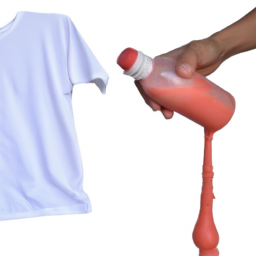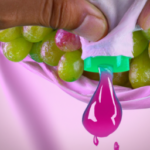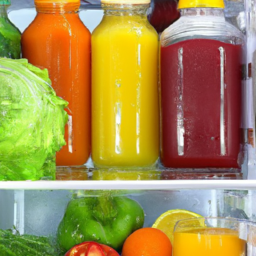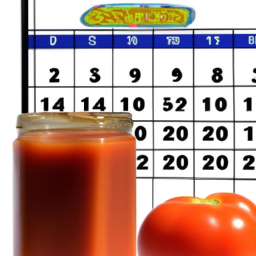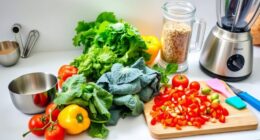As a fan of strawberries, I have firsthand experience with the frustration of trying to remove juice stains from my clothes. Whether it’s from a smoothie or a fresh slice of the fruit, that bright red liquid is known for leaving stubborn marks on fabric that seem impossible to get out.
However, with the right techniques and a little bit of patience, you can easily get strawberry juice out of your clothes and restore them to their original state.
In this article, I will share my tried-and-true methods for removing strawberry juice stains from clothes. From assessing the severity of the stain to preventing future stains, I will guide you through each step of the process with professional knowledge and firsthand experience.
By the end of this article, you will be equipped with the tools and knowledge you need to tackle even the toughest strawberry juice stains and keep your clothes looking fresh and clean.
Key Takeaways
- Assess the severity of the stain before attempting to clean it.
- Blot the stain with a clean cloth or paper towel instead of rubbing it.
- Use stain removers like hydrogen peroxide or vinegar and test on a small area first.
- Check the care label before washing and avoid hot water, as it can make the stain worse.
Assess the Severity of the Stain
Before diving into the cleaning process, it’s important to take a moment to assess just how much damage that pesky strawberry stain has done to your favorite shirt. So, let’s see what we’re dealing with, shall we?
Identifying stains is the first step towards a successful removal. Differentiating fresh and old stains is also crucial because the cleaning method will vary depending on the age of the stain.
Fresh strawberry stains are easier to remove compared to those that have set in for a while. Fresh stains can be treated with just water and mild detergent. However, if the stain has been sitting for a few hours or days, it may require a more aggressive approach.
With that said, let’s move on to the next step of the cleaning process – blotting the stain.
Blot the Stain
When dealing with a strawberry juice stain, the first step is to blot the stain as quickly as possible.
I always use a clean cloth or paper towel to do this, being careful not to rub the stain into the fabric.
Rubbing the stain can actually make it worse and can cause the stain to spread, so it’s important to avoid doing so.
Use a clean cloth or paper towel
To remove strawberry juice from clothes, grab a clean cloth or paper towel and gently blot the stain. Using paper towels for stain removal has many benefits. They are absorbent, disposable, and easily accessible. Plus, you don’t have to worry about transferring the stain to another piece of clothing or surface.
However, if you don’t have paper towels on hand, there are alternatives to using them for stain removal. A clean, white cloth or even a napkin can work just as well. Just make sure the cloth is dampened with cold water before blotting the stain. Remember to blot gently, as rubbing can cause the stain to spread and become even larger.
Avoid rubbing the stain
Remember, don’t rub the stain if you want to avoid making it worse! When dealing with strawberry juice stains, it’s crucial to remember that rubbing only spreads the stain and pushes it deeper into the fabric.
Instead, consider alternative methods such as dabbing or blotting the affected area. Gently press down on the stain to absorb as much of the juice as possible. The key here is to act fast and avoid letting the stain set in.
The importance of quick action cannot be overstated. The longer the juice sits on the fabric, the more difficult it becomes to remove. So, as soon as you notice the stain, grab a clean cloth or paper towel and start blotting. If the stain is particularly stubborn, you can try using a stain remover or a mixture of water and vinegar.
With a little bit of patience and persistence, you’ll be able to remove the stain successfully. Now, let’s move on to the next step – rinsing the stain.
Rinse the Stain
When I’m trying to remove a stain, I always start by rinsing it with cold water. This helps to prevent the stain from setting and makes it easier to remove.
I also make sure to rinse the stain from the back of the fabric, pushing the stain out instead of rubbing it in further.
Use cold water
Cold water’s the trick for getting strawberry juice out of clothes, so don’t hesitate to give it a good soak. When it comes to laundry, using cold water has its benefits. Not only does it save energy and money, but it also helps preserve the color and quality of your clothes. But did you know that cold water is also the best choice for removing stains?
Hot water may seem like the obvious choice for stain removal, but it can actually set the stain and make it even harder to remove. On the other hand, cold water helps to prevent the stain from setting and allows for a more effective removal process. So, when dealing with a pesky strawberry juice stain, always opt for cold water.
To further emphasize the importance of using cold water for stain removal, here’s a table comparing the differences between cold and hot water:
| Cold Water | Hot Water | |
|---|---|---|
| Energy | Uses less energy | Uses more energy |
| Stain Removal | Takes longer but is more effective | May set the stain |
| Color Preservation | Helps preserve colors | May fade colors |
Now that we know the benefits of using cold water, let’s move on to the next step: rinsing the stain from the back of the fabric.
Rinse from the back of the fabric
To effectively remove the stain, begin by rinsing the affected area from the back of the fabric. This is important because it helps to prevent the stain from spreading and setting into the fibers of the fabric. When rinsing the fabric, use cold water and allow the water to run through the fabric from the back side of the stain. This helps to push the stain out of the fabric instead of pushing it further in.
Prevention techniques are also important when dealing with strawberry stains. It’s best to avoid wearing light-colored clothing when consuming strawberries. Additionally, if you do spill strawberry juice on your clothing, try to treat the stain as soon as possible. There are alternative cleaning methods that you can use if the stain does not come out with just rinsing. However, be sure to test them on a small, inconspicuous area of the fabric before trying any alternative cleaning methods to ensure they don’t cause any damage.
With these tips in mind, you can effectively remove strawberry juice stains from your clothing. Next, apply a stain remover to the affected area for best results.
Apply a Stain Remover
First, grab a stain remover and gently apply it onto the strawberry juice stain on your clothes, being careful not to rub it in further. When choosing a stain remover, consider the type of fabric and the severity of the stain. There are various types of stain removers available in the market, such as hydrogen peroxide, vinegar, or commercial stain removers. It’s advisable to read the instructions on the label before using it.
Precautions should be taken while using a stain remover. Always test the stain remover on a small, inconspicuous area of the fabric first, to ensure that it doesn’t cause any discoloration or damage. It’s important to follow the instructions on the label and avoid leaving the stain remover on the fabric for too long. Additionally, it’s essential to rinse the fabric thoroughly after applying the stain remover.
After applying the stain remover, it’s time to wash the clothes.
Wash the Clothes
Now you need to put your clothes in the washing machine and add your preferred laundry detergent. Before starting the wash cycle, make sure to check the care label of your clothes to ensure that they can be washed in the machine. If the label indicates that the clothes should be hand washed, do not put them in the washing machine.
Once the clothes are in the machine, you can add some pre-treating options to help remove any remaining stains. You can use a pre-treating spray or liquid detergent directly on the stained area and gently rub it in. Let it sit for a few minutes before starting the wash cycle. After the wash cycle, check the clothes for any remaining stains. If any stains remain, do not dry the clothes. Instead, repeat the pre-treating and washing process before drying them. Speaking of which, drying techniques will be discussed in the next section.
| Pre-treating options | Drying Techniques | Tips for success |
|---|---|---|
| Pre-treating spray or liquid detergent | Air-drying outside in the sun | Check the care label of your clothes |
| Baking soda and vinegar paste | Tumble-drying on low heat | Use a pre-treating option before washing |
| Lemon juice and salt mixture | Hang-drying indoors | Do not dry clothes with remaining stains |
Now that the clothes have been washed, it is important to check for any residue before drying them. Any residue left behind can cause discoloration or damage to the fabric. In the next section, we will discuss how to check for residue and ensure that your clothes are completely clean.
Check for Residue
After washing the clothes, it’s crucial to inspect them for any leftover residue. This is essential to prevent any damage to the fabric during the drying process.
Sometimes, even after washing, some residue may remain on the fabric. To avoid this, preventive measures can be taken, such as using a stain remover before washing or using a more powerful detergent.
If there is still residue left on the clothes, alternative solutions can be used to remove it. One option is to soak the fabric in a mixture of water and vinegar, which can help break down the residue. Another option is to use a solution of baking soda and water, which can be rubbed onto the affected area and left to sit for a few minutes before washing.
By checking for residue and taking necessary steps to remove it, you can ensure that your clothes come out of the wash looking clean and stain-free.
With the residue removed, the next step is to treat stubborn stains that may be left behind.
Treat Stubborn Stains
To effectively remove stubborn stains, you’ll need to target them with specific treatments that will penetrate deep into the fabric. First, consider preventive measures to avoid making the stain worse.
Blot the area gently with a clean cloth to remove any excess liquid, but avoid rubbing the stain, which can spread it further. If possible, treat the stain as soon as it happens to prevent it from setting.
If the stain persists, try alternative remedies before resorting to harsh chemicals. For example, mix one tablespoon of white vinegar with two cups of cold water and dab the solution onto the stain with a clean cloth. Alternatively, mix one teaspoon of dish soap with one cup of cold water and apply the solution to the stain, then let it sit for 10-15 minutes before rinsing with cold water. These natural remedies are gentle on fabrics and can be effective at removing tough stains.
To avoid common mistakes when trying to remove stubborn stains, follow these tips. First, never use hot water on a stain, as this can set the stain and make it even harder to remove. Additionally, avoid using bleach or other harsh chemicals without testing them on a small, inconspicuous area of the fabric first.
By taking these precautions and using targeted treatments, you can effectively remove strawberry juice stains from your clothes.
Avoid Common Mistakes
Make sure you don’t make common mistakes when trying to remove stubborn stains from your garments. One of the most common misconceptions is using hot water to remove stains, as it can set the stain into the fabric and make it almost impossible to remove. Instead, you should use cold water to rinse the stain first, and then pre-treat it with an effective cleaning solution.
Another common mistake is rubbing the stain vigorously, which can damage the fabric and spread the stain further. Instead, gently blot the stain with a clean cloth or paper towel to absorb as much of the liquid as possible. Then, apply the cleaning solution and let it sit for a few minutes before washing the garment as usual.
With these tips in mind, you can effectively remove stubborn stains without damaging your clothes.
Now, let’s move on to the next step: drying the clothes.
Dry the Clothes
Now it’s time to toss those freshly cleaned clothes into the dryer, and feel the satisfaction of watching them tumble around and emerge warm and fluffy. However, before you do that, make sure that you’ve checked the care label on the garment to ensure that it’s safe to put in the dryer. If the label recommends air drying, then skip the dryer and hang the clothes up to dry instead.
Here are some tips to help you dry your clothes effectively:
- Use a low or medium heat setting on the dryer to prevent shrinkage and damage to the fabric.
- Add a fabric softener sheet to reduce static cling and add a pleasant scent to the clothes.
- If air drying, hang the clothes up on a clothesline or drying rack, making sure that they are not bunched up or touching each other.
- If ironing is necessary, make sure that the garment is completely dry before ironing to prevent setting the stain.
Now that your clothes are clean and dry, it’s time to think about how to prevent future stains.
Prevent Future Stains
If you want to keep your clothes stain-free, it’s important to stay on top of spills and accidents before they snowball into bigger problems. Preventive measures can go a long way in ensuring that your clothes remain in good condition, and that you don’t have to deal with the hassle of removing stubborn stains. One long term solution is to invest in stain-resistant clothing that repels liquids and prevents them from seeping in. This can be especially useful for children or those who are prone to spills.
Another way to prevent future stains is by being mindful of what you wear when you eat or drink. Certain fabrics, such as silk or linen, are more susceptible to stains than others, so it’s best to avoid wearing them when consuming messy or colorful foods. Additionally, using a napkin or bib can provide an extra layer of protection for your clothes. By taking these simple steps, you can save yourself time and effort in the long run, and keep your wardrobe looking fresh and clean.
| Column 1 | Column 2 | Column 3 | Column 4 |
|---|---|---|---|
| STAINS | FRUSTRATION | WASTE OF TIME | EMBARRASSMENT |
| CLEAN CLOTHES | HAPPINESS | PRODUCTIVITY | CONFIDENCE |
| PREVENTION | PEACE OF MIND | SAVES MONEY | PRIDE |
| CAREFULNESS | SATISFACTION | HYGIENE | SELF-RESPECT |
This table highlights the emotional responses that can arise from stains and clean clothes. By focusing on the positive outcomes of preventive measures, such as peace of mind and satisfaction, it can encourage individuals to take action and protect their clothing. By incorporating these tips and strategies into your daily routine, you can prevent future stains and maintain your wardrobe for years to come.
Frequently Asked Questions
Can I use bleach to remove strawberry juice stains?
Using bleach for strawberry juice stains can be effective, but it carries the potential risk of damaging the fabric. To properly dilute bleach, mix one tablespoon of bleach with one quart of water. Always spot test before applying to the stained area.
How do I remove strawberry juice stains from delicate fabrics like silk or wool?
Removing fruit stains from delicate fabrics can be tricky, but using natural remedies for stain removal can be effective. Try mixing equal parts white vinegar and water and dabbing the solution onto the stain, then rinse with cold water and repeat if necessary. Avoid using bleach on delicate fabrics.
Is it safe to use hot water when rinsing the stain?
Hot water can be effective for removing stains, but it also has its drawbacks. It can set some stains, like protein-based ones, making them harder to remove. For strawberry juice stains, pre-treating with vinegar or lemon juice is best.
Can I skip the stain remover step and go straight to washing the clothes?
Skipping the stain remover step and going straight to washing the clothes may not be effective in removing strawberry juice stains. It is recommended to pre-treat the stain with a stain remover before washing using effective washing techniques.
How long should I let the stain remover sit on the stain before washing the clothes?
Personally, I recommend pre-treatment techniques to remove tough stains. Soaking duration typically depends on the severity of the stain, but a good rule of thumb is to let the stain remover sit for 10-15 minutes before washing.
Conclusion
In conclusion, getting strawberry juice out of clothes can be a hassle, but following the steps outlined above can make the process much easier.
By assessing the severity of the stain, blotting and rinsing it, applying a stain remover, and washing and drying the clothes properly, you can effectively remove the stain. For stubborn stains, using vinegar or baking soda can be helpful.
One anticipated objection to these methods may be that they’re time-consuming and require a lot of effort. However, it’s important to remember that the longer a stain is left untreated, the harder it will be to remove.
Investing a little extra time and effort in the beginning can save you from having to buy a new piece of clothing in the long run. Plus, knowing how to remove stains is a valuable skill that can come in handy in many situations.
Ilana has been a vegan for over 10 years. She originally made the switch for health reasons, but soon found herself becoming more and more passionate about the ethical and environmental implications of a vegan lifestyle. Ilana is the author of The Graceful Kitchen, a blog all about veganism. She loves to cook up delicious and nutritious vegan meals, and share her recipes with others who are interested in leading a cruelty-free life. Ilana is also a strong advocate for using whole foods as the foundation of a healthy diet, and believes that going vegan is one of the best ways to achieve this.

